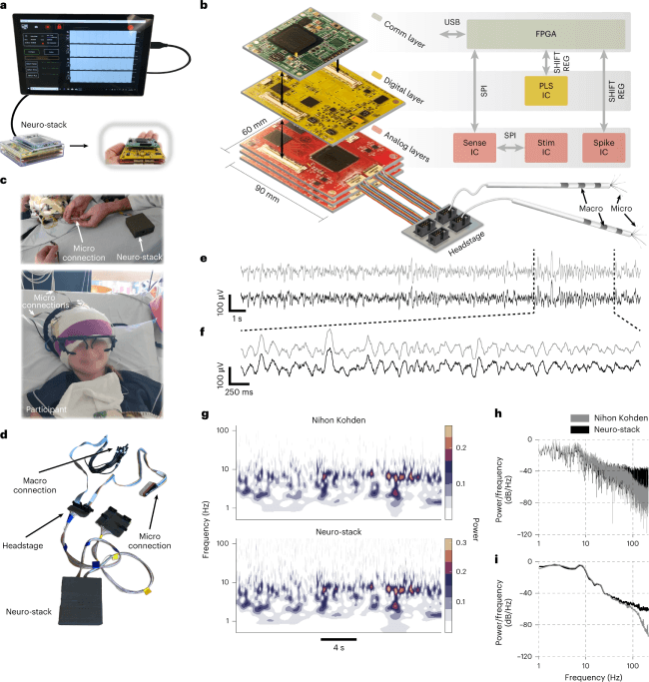UCLA's Single-Neuron Activity Detection Device: The Future of Neurological Treatment?
In The News | 16-03-2023 | By Robin Mitchell
Researchers from UCLA have developed a new wearable device that can detect single-neuron activity in the brain, overcoming challenges in monitoring brain activity using non-invasive methods. This breakthrough in neuron detection and data processing can lead to new connections between neural sciences and advancements in treating motor disorders, paralysis, and even robotic prosthetics through implanting electrodes and closed-loop systems with feedback. What challenges does neuron detection face, what did the researchers demonstrate, and how could such a device help with future technologies?
What challenges does neuron detection face?
Understanding the function of neurons is critical for understanding everything that there is to be human, as neurons are the processing elements of the brain. At the same time, it is also essential that researchers not only understand how neurons work but how new connections are made, how those connections help to process new data, and why some conditions are capable of causing serious dysfunction while losing half the brain can still see a full recovery.
Studying neurons under a microscope provides insights into the function of individual neurons, but trying to understand how neurons in a large collection, such as the brain, cannot be done using such techniques. It is possible to map the electrical activity of the brain via non-invasive methods, but this only provides insight into the large-scale electrical activity of the brain with very low resolution. For example, it is possible to tell if someone is dreaming but not possible to see what that dream is about.
To make matters worse, the equipment needed to monitor brain activity can often be cumbersome, making it difficult to monitor activity when not sitting down. This makes it hard to understand how the brain copes with activities such as motion, something that researchers are desperate to understand as this could help unlock the cure for paralysis and even motor disorders.
Researchers create wearable single-neuron device
Recognising the challenges faced with detecting neural activity, researchers from the University of California, Los Angeles (UCLA) recently published a paper outlining a wearable neural interface device that allows for single-neuron monitoring. The device, no larger than a stack of cards, comprises multiple stacked boards that include multiple analogue interface channels, a digital interface layer, and an FPGA comms layer. This stack of devices is then connected to individual electrodes that are implanted in the brain of a test subject, and from there, individual neural activity can be monitored.
So far, the device is able to connect to 256 individual contacts providing a total of 128 monopolar or bipolar recordings with a sample rate of 6,250Hz. If the number of connections is reduced to 32, the recording rate can be increased to 38.6kHz. At the same time, the device is also capable of injecting signals into a test subject, creating close-loop systems whereby recorded neural activity can be interfered with. The use of an onboard Tenso multiplication acceleration unit also allows neural networks to decode neural patterns in real-time to help create more intelligent closed-loop feedback systems.
Finally, the system can be operated both over USB and wireless networks, enabling the device to be worn by the test subject while still being able to move around. This enables the device to record neural activity during walking and running accurately.

How could such a device help with future technologies?
By far, one of the most promising uses for such a device is to help control conditions such as epilepsy, where the uncontrolled rapid firing of neurons can cause convulsions and unconsciousness. Before an epileptic attack, there is usually a build-up period whereby individuals are aware that they may soon face an episode. The device developed by the researchers could easily detect these build-up periods and inject signals to override the rapid neural activity, thereby eliminating the episode entirely.
Such a device could also become critical in restoring motion to those who suffer from neurodegenerative diseases or paralysis. If the intention to move limbs can be successfully decoded (thanks to the use of neural networks), it is possible that this device could be combined with robotic prosthetics that translate intention into action. The use of closed-loop systems could even provide feedback from limbs, giving humans the ability to feel the robotic limbs and make real-time adjustments to account for weight shifting, unstable ground, and even texture.
What the researchers have presented is truly exciting and opens up the opportunity to significantly advance developments in the field of neural sciences. Of course, the next step is to further increase the number of simultaneous connections and explore new technologies for implanting electrodes that can be used with the developed device.

